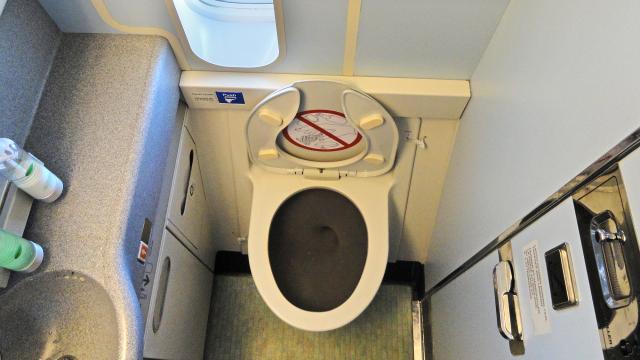Flying has become an altogether unpleasant experience, from long security lines at the airport to cramped, uncomfortable seats. But one of the more unsettling parts of flying, those aeroplane toilets that sound like jet engines when flushed, might soon be much quieter thanks to some long overdue research from Brigham Young University.
Minimising weight on a plane also reduces fuel needs and costs, so the toilet you have at home, which uses a heavy tank of water to flush the bowl clean, poses logistical problems for a plane. (Not to mention the inevitable and unpleasant slosh of dirty water whenever an aircraft hit turbulence.)
Toilets in modern passenger planes instead rely on a non-stick coated bowl and a tremendous amount of suction to transfer waste mixed with a minimal amount of water to a holding tank.
The force of suction can often move air and water at speeds of over 480km/h, and any point where that flow of materials is obstructed, such as a bend in a pipe, results in a lot of noise being generated. On top of that, the sounds of valves quickly opening and slamming shut adds to the din that’s now more apparent than ever as aeroplane cabins have gotten quieter.
In a recently published paper aptly titled “Noise Reduction of a Vacuum-Assisted Toilet”, researchers from Brigham Young University found a few minor design modifications were able to significantly reduce the roar of a toilet.
By simply adding more distance between the flush valve and the toilet bowl with extra pipe, the sound of the flush valve being opened and the suction starting dropped by 16-decibels, and a reduction of five to 10-decibels while it was fully open.
The plumbing that connects each toilet to the plane’s holding tank also often includes an abrupt 90-degree angle just below the bowl, which generates a considerable amount of noise as the high-speed flow bounces off pipes while changing direction. By changing this to a more gradual curve, the toilets were further quieted.
There’s no word on when the improvements will eventually find their way into aeroplane toilets — airlines seem less than focused on improving passenger comfort — but the research could also benefit the design of low-flow and eco-friendly toilet alternatives back on the ground too.
The less water a toilet can use the better for everyone, but no one wants a toilet in their home that leaves their ears ringing after each flush.
[Ingenta Connect via EurekAlert!]
